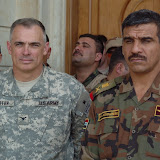Baghdad: Embedded Provisional Reconstruction Teams
Counterterrorism Blog
By Daveed Gartenstein-Ross
May 31, 2007
A few days ago, I spoke with a U.S. official working for one of the new embedded provisional reconstruction teams (EPRTs) in Iraq. Last year ten provisional reconstruction teams (PRTs) were created throughout the country to operate parallel to the military. Each PRT was headed up by a foreign service officer; had a deputy from the U.S. Army; had at least one member from USAID; and had a bilingual, bicultural advisor (fluent in Arabic with a background that allows him to understand the Middle East). Typically there would be about ten people total working for a PRT. The PRTs were designed to further the U.S. mission in Iraq by helping to advance the political process of reconstruction in a variety of ways. Top-down change was characteristic of the PRTs: they would work with such political entities as city councils and the policymaking portion of a city's department of public works.
The EPRTs are different. Rather than operating separately from and parallel to the military, they are embedded within the military structure. Six EPRTs operate in Baghdad, three in Anbar, and one in Babil. Their structure is similar to that of the PRTs (run by a foreign service officer, featuring a U.S. Army deputy, a USAID member, a bicultural advisor, and other staffers) but rather than functioning in the top-down manner of the PRTs, the EPRTs are designed to make more of a difference at what the official called the "granular" level. That is, the EPRTs are integrated into the military's tactical operations, and are designed to advance reconstruction efforts on a street by street, neighborhood by neighborhood basis. I previously noted that the 2nd Battalion, 32nd Field Artillery (with which I was embedded) has four lines of operation in the districts it patrols: security, governance, economy, and essential services. It is at this tactical level -- the level of how these lines of operation can be furthered -- that the EPRT is supposed to have an impact in helping to set the course for the units with which it works. The EPRTs help set this course all the way down to the platoon level.
The source working with the EPRT said that their job is as much "problem avoidance" as anything else. Moreover, because the EPRTs have only been active in Iraq for about six weeks, it's too early at this point to assess their effectiveness. However, I'll be interested to check in with people working with the new EPRTs several months down the line to see how this intriguing idea is working in practice.
Thanks to Public Multimedia Inc. for its assistance in organizing my embedded reporting from Iraq. You can support my embed and independent reporting through donations to the Counterterrorism Foundation.








